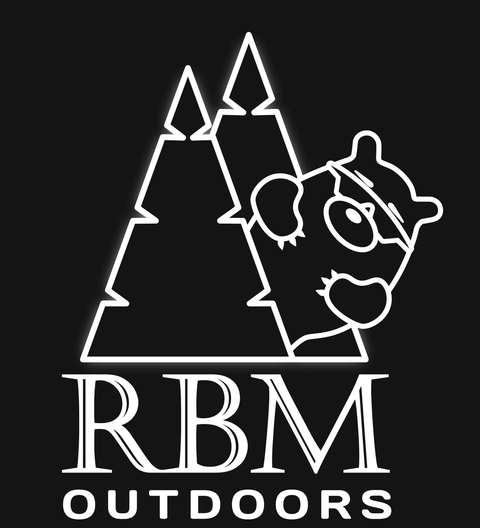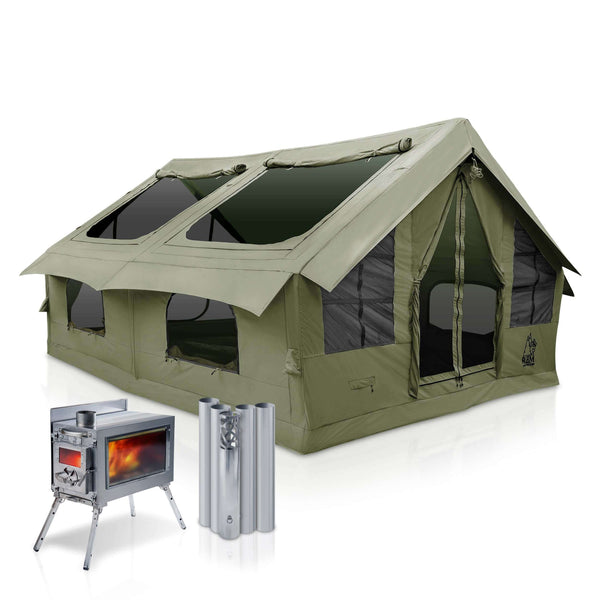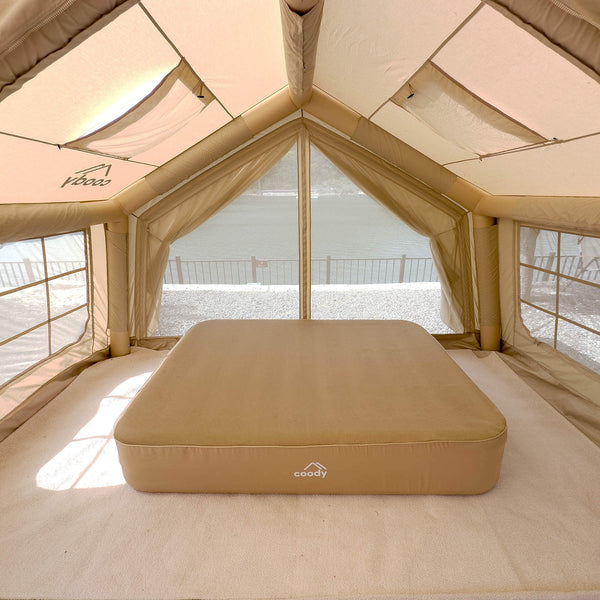Camping in a tent during winter isn’t just about braving the cold—it’s about smart planning and survival skills. This detailed guide walks you through every step of how to set up a tent in snow, from choosing a safe, wind-protected site to anchoring your shelter with snow stakes or digging into packed snow. It covers essential gear like 4-season tents with stove jacks, double sleeping pads, and proper winter clothing, as well as safety tips to avoid hypothermia, frostbite, carbon monoxide poisoning, and fire hazards. Whether you're tent camping in snow for the first time or looking to refine your winter routine, this is your go-to blueprint for building a secure, warm, and functional snowy campsite.
Don't want to read? Listen to our podcast!
Contents
How do I set up my tent in winter?
A hiking or hunting trip in winter is an extremely exciting experience in its own way. It is different from summer camping and has its own specifics. Needless to say, it takes some endurance and skill to have a successful trip. You should be ready to survive in a freezing cold weather, know how to set camp out in snow, stay warm at midnight, stay fed and hydrated, etc.
What are the biggest challenges of winter camping?
There are some paramount tasks to perform and dangers to avoid. No matter how good you are at doing the work in deep snow, prepare yourself to do the following:
- Learn the trick of setting up a tent in winter.
- Collect and prepare your gear.
- Stay warm and choose a suitable way of heating your place. Be sure you have extra clothes, sleeping bags, or blankets at hand.
- Be ready for a sudden change in weather.
- Eat and hydrate properly.
- Prevent frostbite and hypothermia.
- Stay away from wild predators.
These are the essentials of surviving the harsh winter environment. Now, let’s break it down a little.

How do I set up my shelter?
-
Take your time!
Now that you have come a long way and spent a load of energy fighting with the cold and trying to reach your destination, you are in for finding and preparing your site. This work is going to take quite a bit of effort. Therefore, do not rush and take a little rest before starting work. Take a good snack and a drink to recharge your batteries.
-
Choose your camping spot
This is the first thing you should be ready for if you are really intent on hiking in winter. It is going to take a bit of research and practice, especially if you are doing it for the first time.
Find the right camping site. It is advisable to choose a spot with level ground and with some vegetation around that could shield you against the wind. Be sure that you are not setting your tent right on top of a bush.
Also, you can choose a place near a hill or in a hollow. Do not put it up at the bottom of a steep mountain because there is a possibility of an avalanche. Stay away from dry and old trees because they may fall right down on you. It should be noted that it is harder to tell a good tree from a dry one in winter than in summer.
Keep off heavy tree branches. They are heavier during cold seasons. The canvas may accidentally get caught on one and get ripped. If it rips badly, it will be a disaster because you will not be able to stay warm if it gets really cold.
If you are going to stay out for several days, it is advisable to camp out near natural sources of water (a stream). However, there may not be any, or they may be buried under a thick layer of snow and/or ice. In this case, you are going to have to prepare water by melting it.
Place your shelter in an area where there is a sufficient amount of sunlight. This will help you stay comfortable on a sunny day.
Try to memorize the location and landscape with an emphasis on landmark objects (a large tree, hill, power pole, etc.), so you won’t get lost in a blizzard.
-
Choose the right type of tent and set it up properly
Now that you have chosen the camping site, it is time to pitch your shelter. By now, you should have bought the right type of canopy. Most campers recommend a four-season tent, which is designed to withstand strong gales and heavy snowfalls. These tents feature thicker canvases and larger rainflies.
Most four-season shelters feature a stove jack – a device, to which a stove-pipe is fixed in such a way as not to let rainwater in. A wood stow will help you heat up the inside and keep you warm. High-quality canopies have a stove area where the floor and walls are lined with a fire-resistant material.
Winter camping implies the use of a greater amount of gear (warm clothes, extra blankets, sleeping bags, etc.). In this situation, you’d better have a little larger shelter. For example, if you are traveling in a group of three, you will be fine with a four-person tent. It will offer extra space for your gear, which you should keep inside.
Pitching a tent on the snow requires a specific approach. If there is bare ground, the process is pretty similar to pitching it in summer, except you are going to have to make more effort to set pegs and poles in the frozen ground. However, if the snow is deep, it is a different story.
Prior to actually pitching it, pack down the snow to make your future floor more stable. Do not forget to prepare a vestibule. You can dig it out using a shovel, then stomp it with your snowshoes or boots. If you fail to do so, you will end up with the floor sinking and melting under your body during the night and the flooring getting bumpy.
If necessary, build a wind-breaking wall that will protect you against the wind. It is advisable to build an arrowhead-shaped wall with the end facing the wind. The wall should have the height of around three feet.
You can dig a little deeper and pitch it below the surface. Do not dig too deep because your tent needs sufficient ventilation.
You should be aware that stakes, which you have previously used in summer, do not work well at this time of the year. It is possible to use sacks filled with some heavyweight material or snow stakes, which are intended for this sort of camping. Your paramount task is to fix your shelter in such a way that it won’t get blown away by a gust of wind.
For example, you can use snow stakes. Dig up holes around your tent and place the stakes in them horizontally. Attach the lines, fill up the holes and pack down the snow. This will help you fix the canopy without worrying about the possibility of it tumbling down or getting blown away. However, you are likely to have difficulty digging up and extracting the stakes because you may struggle with pulling them out. Therefore, if you are planning to pitch in this fashion, be sure that you have an ice axe with you.
You’d better take an extra set of snow stakes, ropes, guylines, etc. because a wind may pick up at any time, and you will need to add stability to your shelter. Be sure that all your gear is packed properly. Do not leave tools, stakes, poles, and ropes outside because they may get snow-drifted, and you may never find them.
If the prospect of hammering or freezing stakes into the ground sounds bad to you, you can use a freestanding canopy. It does not have a staking system, so you place it right on the footprint that you have made. The weight of your bodies and gear will keep it standing solid. Besides, you can strengthen it a little by digging the sides in the snow along the perimeter. The biggest drawback of such tents is that they are less stable in windy weather.
Equip your camping site
Once you are out in the wilderness, you will realize that snow is your best friend. You are free to use it as construction material and add some infrastructure to your camp site. Just be sure you have shovels, hammers, axes, pickaxes, and other tools that may come in handy.
For example, you can build a kitchen near your shelter with a table, seats, and a storage cabinet. Here you are free to use your imagination and call all your creative potential into service. If you do not have a wood stove, dig a hole for a campfire. Just be sure it is located safely away from the canopy, so it won’t catch fire.
Needless to say, there is hardly a more exciting thing to do for your kids than building things from snow. They will be happy to assist you, and together you’ll make a killer team and build your camp in no time.
If you have an extra tarp, poles, or a floorless tent, you can build a roof for your kitchen. Do not forget to build wind breaks around it. This will protect you against gusty winds and allow you to have your meals with a due amount of comfort.
Another good thing about this approach is that you are not going to harm the environment in any way. Therefore, building a kitchen is actually part of the Leave No Trace ethics.

Take care of food and drink
You should be aware that winter camping takes a lot of energy. What can really keep you fit for doing the job is a decent source of calories and water. On the other hand, winter hiking implies that you feed and drink properly while saving a good amount of energy. It is advisable to use nutritious yet simple meals. These should contain the basic set of nutrients: carbohydrates, fats, proteins. In this context, quick sandwiches and snacks will be okay. This approach will free you from having to spend hours in the cold cleaning dishes and cups.
It is a cold season, so it is imperative that you have some hot food from time to time. Apart from sandwiches, you should have light breakfast sets in storage. Activity is always a driver in freezing cold, so please do not go for long lunch breaks. Cooling down too much can reduce your physical fitness, cause premature exhaustion, and won’t let you manage all your businesses. Instead, you can take several short breaks throughout the day. This will keep you fit and braced up for further activities. Be sure to take the needed amount of liquid. This can be hot water, herbal teas, soups, broths, etc.
Stay warm inside
The most important thing about winter hiking is sleeping with comfort. This would be hardly possible without maintaining a comfortable temperature inside. A wood stove is the best option. However, in order to bur it safely and effectively, you need to follow the guidelines.
Staying warm at night is an absolute must. Now that you have heated up your place, you are to ensure that it will get you through the night. Bring sleeping bags to your camp site. They have proved to be remarkably effective in freezing weather. Buy one that is designed for lower temperatures than you expect to face during your trip. Sleeping bags have hoods and zippers.
However, a sleeping bag alone does not provide sufficient insulation and cushioning between you and the cold floor that rests directly on the snow. You need to use at least two sleeping pads of different types: a closed-cell foam pad (directly on the floor), and a self-inflatable pad (on top of the closed-cell foam pad).

Safety tips
There are three biggest dangers that accompany winter camping:
- To avoid frostbites and hypothermia, do as recommended above to stay warm in your shelter. Pay attention to your clothing and use the three-layer approach. This means that you wear three layers of clothes.
The base layer is underwear that is in direct contact with your skin. Polyester and wool wear will absorb sweat and dry quickly.
The middle layer does a big part of the job, as it functions as insulation. Most campers recommend fleece jackets and pants. Be sure that you have a supply of (wool) socks.
The outer (shell) layer shields you from the harsh outside influences. Make sure that you are wearing waterproof yet bearable coat, jacket, pants, and boots, and no amount of water goes through. If you fail to keep your clothes dry, you will feel extremely uncomfortable and may go down with hyperthermia and frostbites. These conditions require professional medical help, which is hardly available in the wilderness.
- Carbon monoxide poisoning is the biggest and potentially fatal condition, which results from inhalation of carbon monoxide – a toxic gas, which is produced due to incomplete combustion that results from lack of oxygen. The poisoning may come on pretty suddenly before you realize what is happening. The whole team may lose consciousness, and there will be no one to help you.
To prevent a tragedy, burn your stove in strict accordance with the manual and provide sufficient ventilation. Sleeping with fire burning is a taboo! Make sure that there is always someone on the watch.
Always check your stove and the flue pipe before using it. Prior to moving out, clean these items from soot, debris, and leftovers from previous uses. This will keep you and your loved ones safe.
- Fire hazard. When it gets cold outside, fire becomes the most valuable source of heat. However, it becomes your fiercest enemy once it gets out of control. Please make sure that you know how to burn your stove. Always cook outside (supposedly, you have built your dream kitchen!), and do not burn a campfire too close to your shelter.
Have fun!
Don’t miss a chance to engage in exciting games and activities, such as skiing, sledding, snowball fighting, wrestling, etc.
FAQ
🏕 How do I set up a tent on the snow?
- Setting up a shelter on the snow is slightly different than setting it up on bare ground. Instead of hammering poles and stakes into the ground, you place snow stakes horizontally into small holes. Ropes that hold the tent are attached to these stakes. If you don’t want to use stakes and ropes, you can buy a freestanding canopy.
📦 What should I do if it gets very cold?
- It is a common thing that it gets cold in winter. If you are going on a camping trip, you should think through how you are going to keep the cold outside of your shelter and protect your body from it. To keep your place warm, you can use a stove and bring high-quality sleeping bags and pads with you.
💡 Is camping in winter safe?
- Yes, providing that you prepare for your camping trip properly and strictly abide by safety recommendations. These will help you avoid frostbites and severe cold.


 Air Tents
Air Tents  Coody 17.2 Inflatable Tent
Coody 17.2 Inflatable Tent  ALL SEASON TENTS
ALL SEASON TENTS  Cold Weather Tents with Stoves
Cold Weather Tents with Stoves  Tent Stoves
Tent Stoves  Tent Accessories
Tent Accessories 





Comments
Samantha Good said:
Staying warm is the hardest
Logan Abbott said:
Thanks for the guide, super helpful
Samson Barron said:
This article is a must read for beginners
Colm Oneill said:
Yeah, camping in winter is fun, but requires wayy more preparation..
Phillip Hassan said:
The first thing you need to do is pick the right camping spot